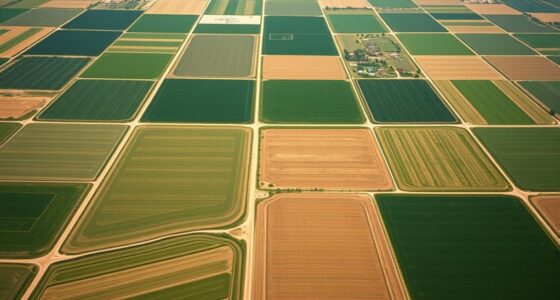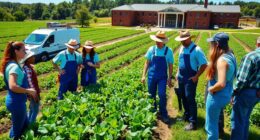Indigenous foodways influence settlers by sharing traditional techniques like open-fire roasting, fermentation, and foraging, which help preserve cultural identities and foster sustainable practices. These methods emphasize a strong connection to land, resisting industrialized food systems and promoting food sovereignty. As settlers adopt or adapt these practices, they encounter lessons in respecting natural cycles and environmental sustainability. To see how these traditions continue to shape food culture today, keep exploring their deeper roots and ongoing impacts.
Key Takeaways
- Indigenous food traditions, such as open-fire cooking and fermentation, influenced settlers’ culinary practices and preservation methods.
- Indigenous control of land-based resources shaped settlers’ understanding of sustainable food sourcing.
- Traditional Indigenous foods and harvesting techniques served as models for settler innovation and adaptation.
- Indigenous practices of food sovereignty and resistance inspired settlers to value local and sustainable food systems.
- The cultural significance of Indigenous foods fostered cross-cultural exchanges that enriched settler diets and food knowledge.

Have you ever wondered how Indigenous communities have preserved their unique food traditions for generations? It’s truly remarkable how these communities maintain their cultural identity through traditional cooking methods that have been passed down for centuries. This preservation isn’t just about recipes; it’s an essential part of their fight for food sovereignty—the right to control and define their own food systems. When you explore Indigenous foodways, you discover how their approach to food goes beyond sustenance, embodying a deep connection to land, environment, and community. Traditional cooking techniques, such as open-fire roasting, fermentation, and foraging, serve as living links to their ancestors and their history. These methods are often sustainable, rooted in a profound respect for nature and its cycles. By practicing traditional cooking, Indigenous peoples resist the homogenizing forces of modern food systems and reclaim their sovereignty over what they eat. Maximize Space and Organization
Indigenous communities have long resisted external influences that threaten their food sovereignty. Instead of relying solely on store-bought or industrialized food, they turn to their land and natural resources. They harvest wild plants, hunt game, and fish, ensuring their diets remain diverse and culturally meaningful. This practice sustains not only their physical health but also their spiritual well-being, reinforcing their identity and autonomy. As settlers and outsiders have increasingly encroached on Indigenous lands, these communities have fought to protect their traditional food sources and methods. They’ve established community gardens, seed banks, and cultural education programs to pass on their knowledge to younger generations. Your role in understanding their food sovereignty is essential, because recognizing the significance of traditional cooking helps you appreciate the resilience and ingenuity of Indigenous peoples.
Frequently Asked Questions
How Did Indigenous Food Preservation Techniques Influence Settler Cooking Methods?
You notice that Indigenous fermentation and traditional smoking techniques greatly influence your cooking methods. By adopting Indigenous fermentation, you learn to preserve foods like vegetables and fish, enhancing flavors and extending shelf life. Traditional smoking techniques inspire you to add depth and preservation to meats. These methods encourage you to incorporate more natural preservation, fostering a deeper respect for Indigenous practices and integrating them into your daily cooking routines.
What Role Did Indigenous Food Rituals Play in Settler Communities?
You find that indigenous food rituals, like storytelling and ceremonial feasts, deeply influence settler communities by shaping their cultural practices around food. These traditions often serve as a way to honor ancestors and build community bonds. You might participate in or observe these rituals, which introduce new foods and preparation methods, fostering respect and understanding for indigenous customs while enriching settler cultural identities through shared stories and festive gatherings.
Which Indigenous Ingredients Became Staples in Settler Diets?
You’ll find that native crops like corn, beans, and squash became staples in settler diets, thanks to indigenous foraging traditions. These ingredients, cultivated and harvested through centuries of knowledge, provided essential nutrition and variety. Settlers adopted these native crops quickly, integrating them into their meals and farming practices, which helped sustain communities and influenced regional cuisine. Their reliance on indigenous ingredients underscores the deep connection between native foodways and settler adaptation.
How Did Indigenous Farming Practices Affect Settler Agriculture?
You see indigenous farming practices revolutionized settler agriculture by introducing sustainable land management techniques. For example, when settlers learned from Native Americans about crop rotation and controlled burns, they improved soil health and productivity. This knowledge boosted agricultural trade, increased crop yields, and fostered a more resilient farming system. By adopting these practices, settlers benefited from indigenous expertise, transforming their approach to farming and land use profoundly.
Were There Conflicts Over Indigenous Food Resources With Settlers?
Yes, there were conflicts over indigenous food resources with settlers. You might find that land disputes and resource conflicts arose as settlers encroached on traditional hunting, fishing, and farming areas. Indigenous communities often resisted losing access to essential resources, leading to tensions and clashes. These disputes reflected broader struggles over land rights and sovereignty, impacting relationships and shaping the history of settler-Indigenous interactions.
Conclusion
You can see how indigenous foodways are the roots that nourish settlers’ traditions, shaping tastes and practices like an unbreakable thread woven through time. Their influence flows quietly yet powerfully, like a river carving valleys in the landscape of culinary history. Embracing this connection deepens your understanding of shared histories and reminds you that, ultimately, food is more than sustenance—it’s a living bridge between cultures, forever echoing the voices of those who came before.










